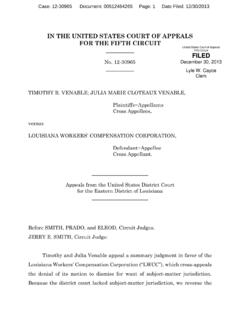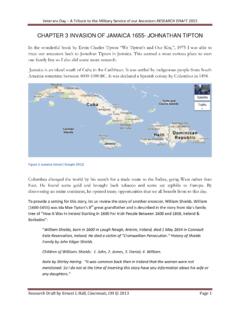Transcription of The Wage Gap Myth
1 National Center for Policy Analysis BRIEF ANALYSIS. No. 392. For immediate release: Friday, April 12, 2002. Entry and Exit from the Job Market. Women are The Wage Gap Myth more likely to enter and leave the workforce to raise children, take care of elderly parents or move with their by Denise Venable families. Working mothers are nearly twice as likely to Tuesday, April 16, 2002, is Equal Pay Day the day take time off to care for their children as are working on which many organizations protest wage discrimination fathers in dual-earner couples. Yet time out of the between men and women. According to the Bureau workforce is an enormous obstacle to building an attrac- of Labor Statistics, the median income for all women is tive resume and working up the corporate ladder. Women about three-quarters that of men, although the results 25 years of age and over have been with their current vary significantly among demographic groups.
2 Feminist employer years, on average, compared to years organizations and some politicians point to these statistics for men. Data from the National Longitudinal Survey as evidence of the United reveal that women be- States as a patriarchal so- FIGURE I tween the ages of 18 and ciety that discriminates 34 have been out of the against women. But a Women's Median Weekly labor force 27 percent of closer examination leads to Earnings as a Percent of Men's the time, in contrast to 11. a different conclusion. 120% percent for men. Women The Good News. ages 45 to 54 who have When women behave in 100% recently re-entered the the workplace as men do, workforce after a five- or the wage gap between 80%. 10-year break are com- them is small. June O'Neill, peting against men who former director of the Con- 60%. have had 20 years of con- gressional Budget Office, tinuous experience. 40%.
3 Found that among people Part-Time Work. ages 27 to 33 who have 20%. Women are also more never had a child, women's likely to work part-time. earnings approach 98 per- 0% In 2000, one-quarter of all One Hour and 1-34 Hours 35-39 Hours 40 Hours 41 Hours and cent of men's. Women Over Over women employees who hold positions and have Weekly Hours Worked worked part-time, com- skills and experience simi- Source: Highlights of Women's Earnings in 2000, Report 952, Department pared to less than 10 per- lar to those of men face of Labor, Bureau of Labor Statistics, August 2001. cent of men. Nearly 85. wage disparities of less than percent of those who 10 percent, and many are within a couple of points. worked part-time did so for non-economic reasons; , Claims of unequal pay almost always involve comparing to spend more time with the family or to further their apples and oranges. education.
4 In general, married women would prefer part- Lifestyle Choices. Women make different choices, time work at a rate of 5 to 1 over married men. and those choices affect how they work. Women often While part-time work usually increases flexibility, the place more importance on their relationships caring part-time worker loses out on promotions and pay in- for children, parents, spouses, etc. than on their creases. Part-time work also tends to mean lower hourly careers. A study by the Center for Policy Alternatives pay. Shorter labor stints and part-time work contribute to and Lifetime television found that 71 percent of women the probability of working for the minimum wage. Nearly prefer jobs with more flexibility and benefits than jobs two-thirds of minimum wage earners are women. with higher wages, and nearly 85 percent of women However, women's wages hold up quite well to men's offered flexible work arrangements by their employers wages when comparing specific job categories.
5 [See have taken advantage of this opportunity. Figure I.] Among adults working between one and 34. Dallas Headquarters: 12655 N. Central Expy., Suite 720 Dallas, TX 75243-1739 972/386-6272 Fax 972/386-0924. Washington Office: 655 15th St. , Suite 375 Washington, DC 20005 202/628-6671 Fax 202/628-6474. For more information: Sean Tuffnell in Dallas at 972/386-6272 or Greg Scandlen in Washington at 202/628-6671. BRIEF ANALYSIS. No. 392. Page 2. hours a week, women's earnings are 115 percent of than 50 percent of associate's, bachelor's and master's men's. Among part-time workers who have never degrees in the 1990s. Women currently earn more than married, and who thus confront fewer outside factors 40 percent of , medical and law degrees. likely to affect earnings, women earn slightly more than The narrowing of the gender wage gap approximately men. These statistics suggest that skill level, tenure and one percentage point a year since 1980 is particularly working hours not gender determine wages.
6 Significant, since during the 1980s and 90s the overall Occupational Choices. Beyond work behavior, wage level rose little and the wage inequality between women gravitate to sectors of the economy that compen- skilled and unskilled workers grew. Without enhanced sate workers at lower levels. While women hold 53 skills, women's wages likely would have fallen further percent of all professional jobs in the United States, they behind men's. However, market pressures have helped hold only 28 percent of jobs in professions averaging to generate corrective mechanisms, and as the costs of $40,000 or more in annual denying employment to FIGURE II. compensation. For ex- women mounted, preju- ample, fewer women have Percent Change in Median dices were set aside. chosen to enter such tech- Conclusion. Wo- nical fields as computer Earnings Between 1979 and 2000. 40. men's work-life patterns sciences, math and science and their occupational pref- teaching, medicine, law and 30 erences are significant fac- Women engineering.
7 In 1998, tors in determining wages. Men women earned only 20 Rather than being fun- percent of computer sci- neled into low-wage, low- ence degrees. 10 prestige and part-time po- Closing the Gap. sitions, women often 0. Despite all these factors, College choose these occupations Graduate the gap between men and -10 Some College or Associate Diploma because of the flexibility women's wages has been High School they offer. After adjusting closing. Figure II illus- -20 Diploma for these factors, scholars trates that over the last 20 find that the difference years women's earnings -30 No High School between men's and Diploma have jumped at least 12 women's earnings is very percentage points relative Source: Bureau of Labor Statistics, 2001. narrow. to men's earnings, closing Those who still cite the wage differential at every level of education. A women's 76 cents for every male dollar as evidence of change in women's work expectations also has tended to sexism fail to take into account the underlying role of close the gap.
8 Until the 1970s, a minority of women personal choice. The wage gap is not so much about expected to work after marriage. Today, almost 75 employers discriminating against women as about women percent of young women expect to be working at age 35. making discriminating choices in the labor market. Changing work expectations are an apparent cause of women's increased focus on education, and the enroll- Denise Venable is with the Women in the Economy ment of women in higher education has grown much project, an initiative of the National Center for Policy faster than that of men. Women were awarded more Analysis. Note: Nothing written here should be construed as necessarily reflecting the views of the National Center for Policy Analysis or as an attempt to aid or hinder the passage of any legislation. The NCPA is a 501(c)(3) nonprofit public policy organization. We depend entirely on the financial support of individuals, corporations and foundations that believe in private sector solutions to public policy problems.
9 You can contribute to our effort by mailing your donation to our Dallas headquarters or logging on to our website at and clicking An Invitation to Support Us.









